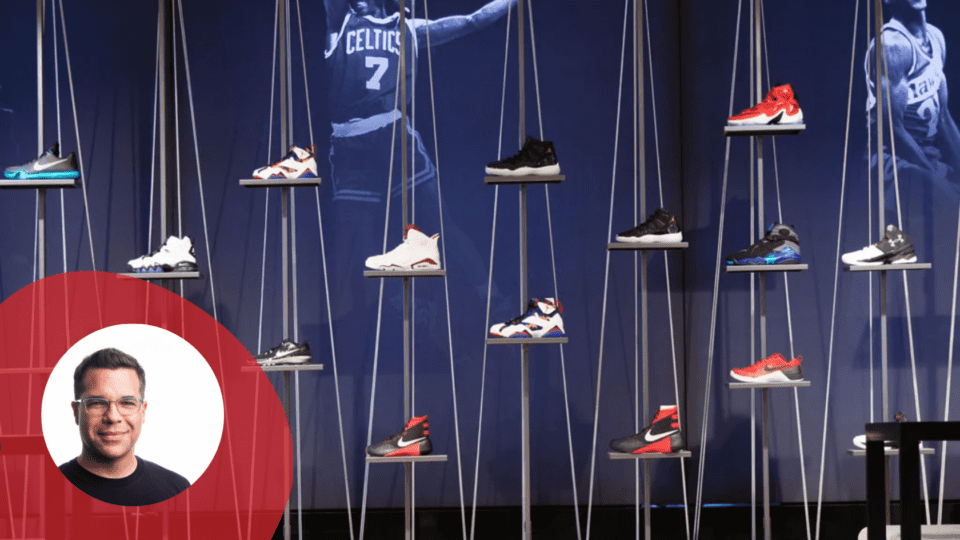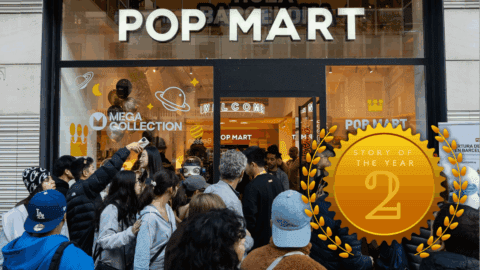Consumers are returning to the physical store for all the advantages it offers: the ability to touch, feel and experience the brand — and most importantly, be a part of the brand’s community or “tribe.” Brands should focus on creating an experiential space that takes advantage of all that in-store has to offer.
Location, Location, Location
It goes without saying that the location is critical. Capitalizing on existing foot traffic in New York means being close to an urban node like Rockefeller Center, Williamsburg, Times Square or Union Square and is important for those brands dependent on walk-in sales. Working on the NBA Store several years ago, the team knew they wanted a location on Manhattan’s iconic Fifth Avenue. We were able to take a run-of-the-mill space and turn it into an attractive and modern multi-level store and best-in-class basketball fan experience. It’s crucial to have a hub that can be a “church” for its superfans, and host events that complement the retail experience.
A brand experience may also become a destination: think of the recent Louis Vuitton and Nike Air Force 1 by Virgil Abloh sneaker exhibit in Greenpoint, Brooklyn — a unique and immersive way to build buzz. Securing the perfect location can be challenging because we need to make sure the building and the use from an occupancy perspective aligns with objectives and that the project can cross through to the finish line in terms of regulatory requirements.
As you go through this essential first stage of your building project — selecting a location — an architect can assist with everything from site selection, due diligence, test fits and ensuring the project is designed and built as the brand envisioned.
Retail-level locations for non-traditional retail brands — think spas and wellness, fitness applications outside of the usual yoga studio, medical, skincare, veterinary, hospitality, office shares, coffee, food, beverage and more — can fall into a grey area: is it retail, healthcare, office, spa, fitness or a combination?
An architect can help identify an appropriate site for a non-traditional retail business, which will depend on what they are offering and what they want to achieve. Upon completion, the project will need its certificate of occupancy — and an architect can ensure this happens as well.
Understanding Optimal Design Features
All retail starts with raw space; making the most of it is key. First, at the ground level, consider how much visibility you have. Glass walls can be a strong asset if you want to be visible and create a compelling street presence. Being on the ground floor and being evident to passersby piques their interest and awareness.
Regardless of what floor you are on, it’s important to make the most of the space, even if doesn’t have the capacity for windows, since a non-traditional retail brand does not require a storefront scenario the way a traditional retailer might. In fact, some businesses thrive in these non-traditional locations.
Second, pay attention to ceiling heights. High ceilings create the feeling of space and abundance. Most first-floor spaces have a healthy ceiling height, which lends itself to flexible design. For our client SKATEYOGI, an innovative skateboarding school for kids and adults, we worked with a location that featured high ceiling heights and brought in a former pro skateboarder and professional half-pipe builder to construct the ramps, creating the best possible facility.
Third, consider the benefits of revitalizing historic properties — also known as adaptive reuse. Recently, we worked on Bathhouse, a new wellness concept with locations in Brooklyn and Manhattan. The Brooklyn location is a former factory, and the Manhattan location is a former parking garage. For both locations, we designed several floors that included a restaurant, treatment rooms, saunas and soaking pools, utilizing the existing infrastructure. Each location is distinct, makes the most of its historic features and offers a truly unique client experience blending traditional with modern.
Street Presence
One of the things you have to contend with when you have street frontage is creating a compelling street presence. Spaces that are inward-looking on the ground floor can serve as a billboard. Utilize artistic flair to create a design or mural that makes the most of the building’s existing features. An excellent example of a creative street presence is Rumble Boxing Gym in downtown Brooklyn, which calls attention to passersby with a large mural of their logo.
Another skateboarding concept, Homage Skateboarding Academy, went completely underground after being on the street level for a decade. Previously, it relied on a street presence and a large open garage door, but with the cellar level it’s secured more space and a better price.
You don’t want people walking by and not seeing your location — unless you are looking for something more discreet — and part of doing this is using the exterior of the property, its location and any unique features to your advantage.
Learning from Other Sectors
Aside from traditional retail, such as banks or fast food, other sectors have a lot to say about creativity. Look no further than immersive museums like New York’s Museum of Ice Cream, ARTECHOUSE and Color Factory, which utilize bold, unconventional design and play with size and scale to create “pop-up” type experiences.
Recently, we designed an immersive museum, Inter_IAM, a new, generative art experience in Manhattan’s SoHo neighborhood that does a good job transporting you out of the physicality of your regular life. While the storefront space is limited, the journey of the experience helps the visitor become completely immersed and lose sense of space and time.
There are also a new wave of health and wellness-related spaces, including our previous example Bathhouse, a spa and wellness concept; Peachy, a provider of skin injectables; and Bar Method, a ballet-inspired workout studio. These spaces might be wellness-focused, but in some cases serve medical functions as well. These are all great examples of brands that do not fit into a “box” yet are still attracting walk-ins and repeat customers alike by utilizing great design.
Creating a Winning Customer Experience
There’s an old saying that it takes 20 years to build a reputation and 20 minutes to lose it; how unique and positive is your customer experience? Because non-traditional retail is about an experience, and not just about having the right merchandise in the stockroom, how can we provide the best possible experience to the consumer? The answer is to think through the entire customer journey and design for an optimal journey.
For example, you don’t want them coming to a spa to escape the hustle and bustle of the city only for it to not live up to their expectations. If you give lessons, you might want to do it in a manner that does not interfere with visitors. Envision the kind of experience you want the customer to have, from the moment they walk in all the way to the cashwrap, and together with your architect, build your concept around that.
Once you have proof of concept, you can increase the space, adjust as you grow, and alleviate any problems. Utilize design to create the best possible customer experience, as a good reputation is the best way to build and expand sales.
Eugene Colberg is a Brooklyn-based architect with over 25 years of experience producing award-winning architecture and interiors in the U.S. and internationally. As Principal of Colberg Architecture, he has designed imaginative and environmentally sensitive projects across the residential, workplace, retail, educational, healthcare, institutional, museum, and urban planning sectors. Having earned his BArch from Cornell University, Colberg is a Registered Architect in the State of New York, a Green Associate of Leadership in Energy and Environmental Design (LEED), and is certified by the National Council of Architectural Registration Boards (NCARB). Colberg Architecture is a Certified Minority Business Enterprise (MBE) with the City and State of New York and the Port Authority of New York and New Jersey. Colberg has worked on prominent retail store rollouts across the world, aligning architecture and in-store design with brand identity. Past projects include Rockefeller Center and prototype development for major brands including Bank United, PNC Bank and Kate Spade, as well as flagship design for stores including National Basketball Association (NBA), Uniqlo, LOFT and Armani Exchange.








